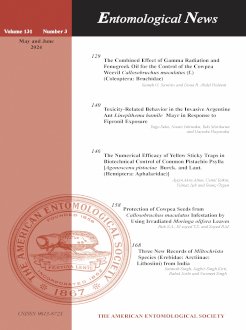Pistachio psylla [Agonoscena pistaciae Burck. and Laut. (Hemiptera: Aphalaridae)] is one of the pests that economically affect the worlwide pistachio production. Due to the harmful effects of chemicals used in pest control, residue problems can occur in products. In this study, the mass capturing efficiency of yellow sticky traps, which are mostly used to determine the appearance period of the pest, was determined with the 1016B coded version of the yellow sticky traps. The study was conducted in Tülmen, Karaköprü, Şanlıurfa (Turkey) province between 2016-2018. In the first year of the study, the difference between the cost of traps and the cost of pest control was determined between 4 traps/tree and 8 traps/tree in 100 trees. It was determined that 4 traps/tree was more economical. In the second and third years of the study, yellow sticky traps were hung on wild almond trees and pistachio orchards to determine the emergence of the pest from hibernation in these locations, and following the determination of emergence, psyllid adults and nymphs were counted on the 4 compound leaves of 10 trees by impact / visual control methods. After the count, traps were hung on 10 randomly selected trees, with 4 traps per tree, at the beginning of March each year. The adhesive on the traps was renewed monthly, and the number of nymphs was compared between March-November following the pistachio phenology on compound leaves with and without traps. In the statistical evaluation of the results of the study, it was determined that the psyllid nymph numbers in the orchards where 4 traps/tree were hung in both years were statistically different compared to the control. However, in 2017, the number of nymphs in the trees where traps were hung was much higher than in 2018, and this difference is assumed to be due to the fact that the precipitation was higher in 2018 and the adult individuals caught in the traps were fewer and the nymphs were damaged by precipitation in the control treatments. In terms of the number of nymphs on the compound leaves, it was determined that in 2017/2018, the number of trapped/control nymphs was 3381 / 6415 in 2017 while in 2018 this value was 3265 / 4746. In conclusion, the results of this study are important in terms of providing an alternative method to chemical control in pistachio integrated pest management and are promising in terms of offering an alternative control opportunity for psyllid control in low and medium populations. However, this method should be expected to reduce the psyllid population below the Economic Damage Threshold, by using it in combination with other control methods, rather than as a control method that can be used alone in high pest populations.
How to translate text using browser tools
16 May 2024
The Numerical Efficacy of Yellow Sticky Traps in Biotechnical Control of Common Pistachio Psylla [Agonoscena pistaciae Burck. and Laut. (Hemiptera: Aphalaridae)]1
Ayçin Aksu Altun,
Cemil Yetkın,
Yılmaz Işık,
İnanç Özgen
SIGN IN TO VIEW ARTICLE

Entomological News
Vol. 131 • No. 3
May 2024
Vol. 131 • No. 3
May 2024
Agonoscena pistaciae
biotechnical control
pistachio
Şanlıurfa
yellow sticky trap




